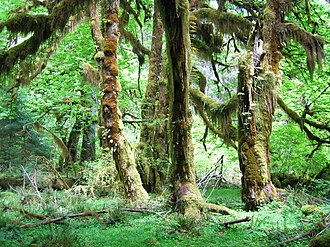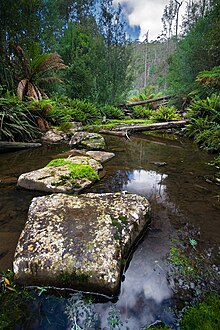Rainforest


As rainforest is called forests caused by a particularly humid climate due mostly more than 2000 mm of precipitation are presented (annual average). Because of the radically different climatic conditions, a distinction is made according to the climatic zones between the rainforests of the tropics (which in a few regions change into subtropical rainforests ) and the moderate latitudes . In a broader sense, the humid forests of the tropics and subtropics are sometimes treated as rainforests.
term
The biologist Andreas Franz Wilhelm Schimper defined and used the term tropical rainforest for the first time in 1898 , which was also adopted in other languages, for example into English as rainforest , in his work Plant Geography on a Physiological Basis (1898).
In the media and popular scientific literature, the term rainforest is often equated with tropical rainforest , since the subtropical and temperate rainforest forms are less well known.
Tropical and subtropical rainforests
Evergreen, tropical rainforests emerged on all continents , on both sides of the equator up to about 10 degrees of latitude , but in some cases well beyond. There they go into the subtropical rainforests . The largest contiguous area - at the same time more than half of the total area of all tropical rainforests - is in the area of the Amazon basin . The Congo Basin in Central Africa and the many islands of Indonesia have other large rainforests .
The term tropical rainforest denotes an ecosystem that includes a large number of forest types: on the one hand, the lowland rainforest up to around 800 m in height, on the other hand, the mountain rainforest up to around 1500 m in height, and finally the cloud and cloud forest beyond 2000 m height. Occasionally, further distinctions are made in the specialist literature for certain regions, for example “cloud forest” for the ridge of the Northern Coastal Cordillera in Venezuela .
Rainforests of temperate latitudes

Rainforests of the temperate zones occur mainly on the west coast of North America , in Chile, as well as on Tasmania and New Zealand . Although the tree species that determine the picture also occur in the temperate deciduous and coniferous forests , they are the most species-rich habitats in these zones.
Tropical and subtropical wet forests
In the warm and humid climatic zone, which is characterized by a monsoon climate , the monsoon forests join, which many authors no longer count as rainforests due to the annual rainfall of less than 2000 mm. Since the rainy seasons there are regularly replaced by dry seasons, the conditions are less balanced than in the tropical rainforest. They are also known as tropical / subtropical wet forests. The most pronounced monsoon forests are found in India and Southeast Asia, as well as in Africa between the rainforests and the humid savannas .
In the cooler east side climate of the subtropics - in which a clear distinction can be made between summer (often with high levels of precipitation) and winter (occasional frost possible) - are the laurel forests , which, depending on the amount of precipitation, can be viewed as wet or rainforests. The largest laurel rainforests are in South China , Florida and Southeast Brazil .
Until now, the tropical forests in particular were considered to be a carbon sink or regulator of carbon dioxide (CO₂) in the earth's atmosphere due to their photosynthesis ability . However, according to a study published in 2020, they store significantly less CO₂ than they did in the 1990s due to global warming . If the negative trend continues, according to the study, rainforests could develop from a CO₂ sink to a CO₂ emitter by 2035. For their analysis, the scientists examined 300,000 trees in the rainforests of the Amazon and Africa over decades. According to the current analysis, the rainforests already stored a third less carbon dioxide in the 2010s than in the 1990s.
See also
literature
- Anton Fischer: Forest vegetation science. Blackwell, Berlin, Vienna 1995, ISBN 3-8263-3061-7 .
Individual evidence
- ↑ Catherine Caufield: The Rainforest: A Waning Paradise . FISCHER Digital, December 29, 2017, ISBN 978-3-10-561946-9 , p. 41.
- ^ David Bruce Weaver: The Encyclopedia of Ecotourism . CABI, January 1, 2001, ISBN 978-0-85199-368-3 , p. 194.
- ↑ a b c Wannes Hubau, Simon L. Lewis, Oliver L. Phillips, Kofi Affum-Baffoe, Hans Beeckman: Asynchronous carboxylic sink saturation in African and Amazonian tropical forests . In: Nature . tape 579 , no. 7797 , March 2020, ISSN 1476-4687 , p. 80–87 , doi : 10.1038 / s41586-020-2035-0 ( nature.com [accessed March 8, 2020]).
- ↑ a b DER SPIEGEL: Climate change: Rainforests store up to 30 percent less CO2 - DER SPIEGEL - Wissenschaft. Retrieved March 8, 2020 .